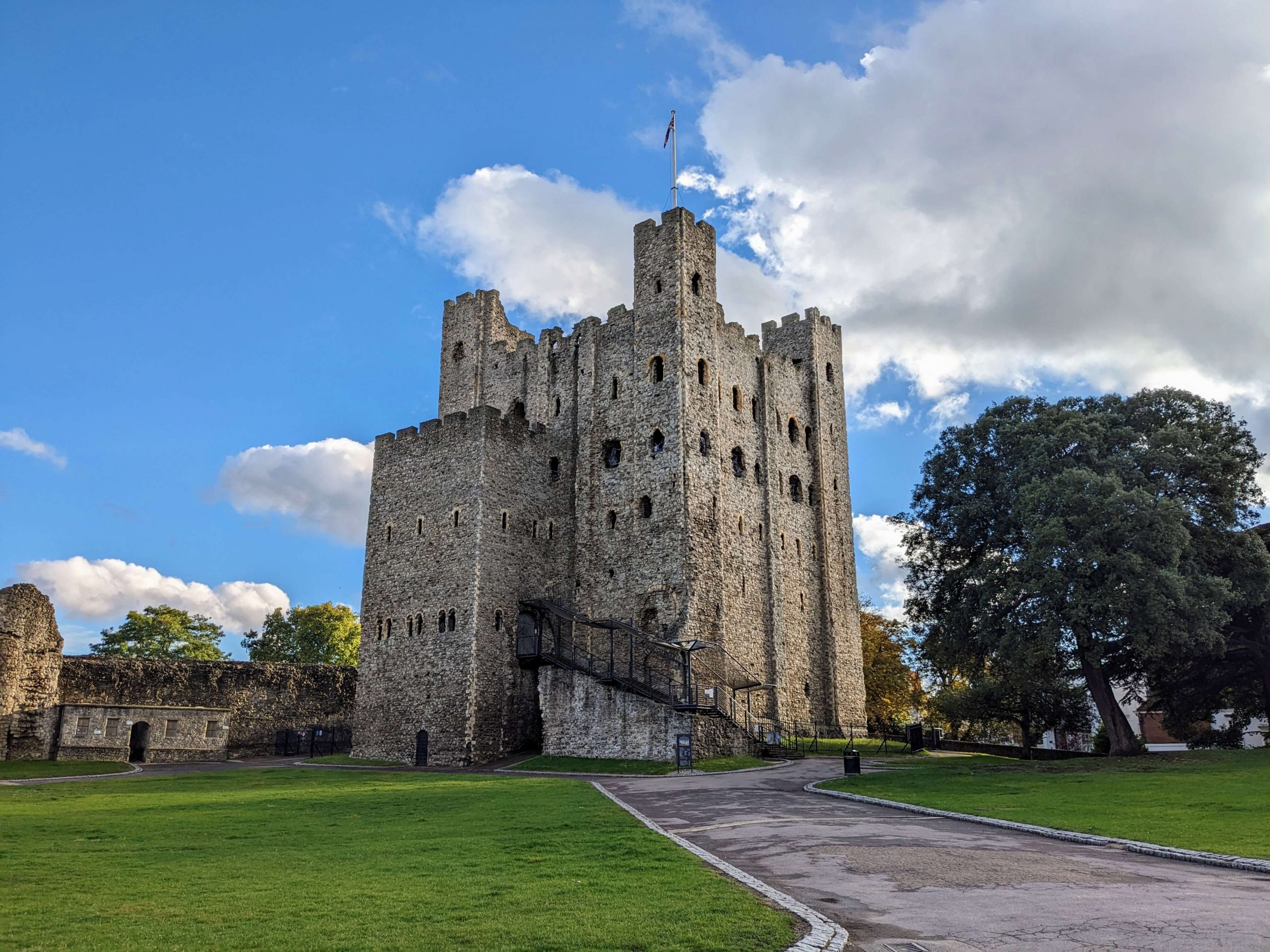For over 800 years Rochester Castle has stood overlooking the River Medway in the historic town of Rochester. The castle is widely regarded as one of the most exceptional examples of Norman architecture in England. Its keep, in particular, stands as the tallest surviving tower of its kind in Europe. The castle played a critical role during the Barons Wars, the siege of Rochester Castle by King John in 1215 is one of the most renowned and well-documented episodes in English history.
| Built | 11th Century |
| Type | Norman Castle |
| Condition | Ruinous – Major Stonework Intact |
| Ownership | English Heritage |
| Access | Public – Admission Fee |
| Postcode | ME1 1SW |
Click here to watch our video exploring Rochester Castle and discover its history
Early History
Rochester is a city steeped in history dating back to Roman times when on the east bank of the river Medway stood a settlement named Durobrivae. It was the location where Watling Street, the road between east Kent and London crossed the river.
Following the Norman conquest an earth and timber castle was built by William the Conqueror and it is believed that William gave the castle to his half brother, Bishop of Odo of Bayeux.
Upon William’s death in 1087, his lands were divided between his two sons. Robert, the elder son inherited the title of Duke of Normandy, while William II ascended to the throne as King of England. This division faced opposition from a substantial group of Norman barons who were against the separation of Normandy and England. Bishop Odo, supported Robert’s claim to the English throne.
Odo was captured at Pevensey Castle and William’s men marched Odo back to Rochester to force its surrender. Despite this, Rochester’s garrison refused and a siege ensued. Supplies to the city were cut off which eventually forced Rochester to surrender, Odo was banished abroad and his lands were seized.
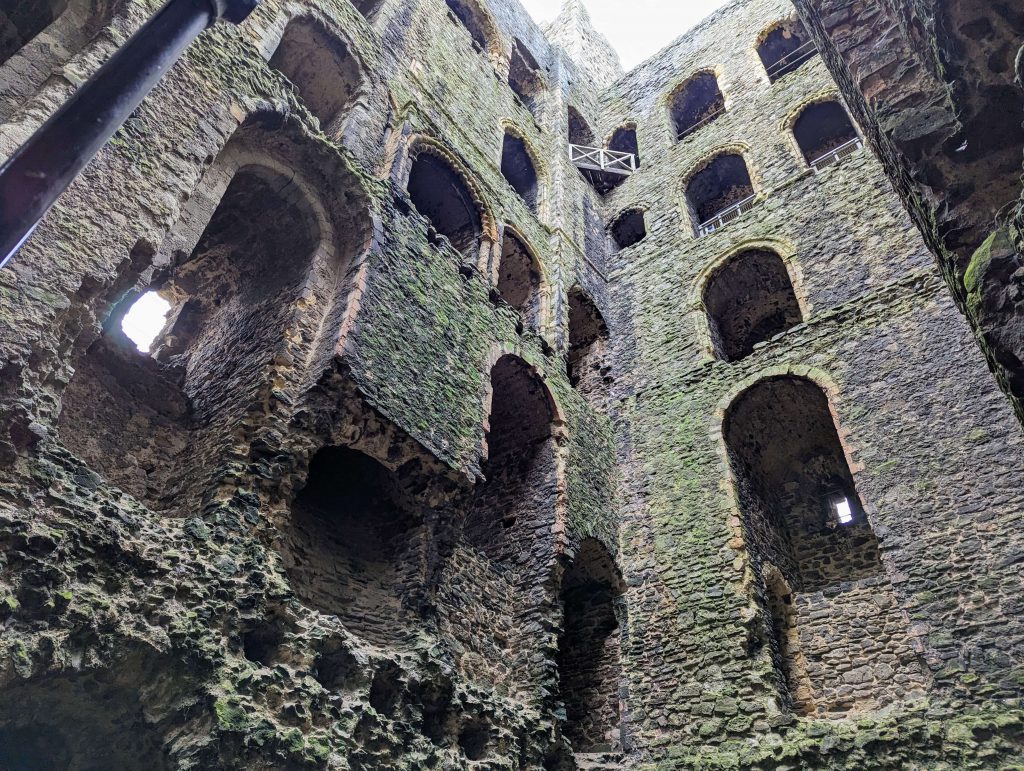

First Stone Castle At Rochester
In about 1087 a new stone castle began to be built in the south-west corner of Rochester’s city walls on the site that the current castle sits on by Gundulf, Bishop of Rochester. Some parts of this castle still remain along the west curtain wall. Gundulf had also overseen the construction of the iconic White Tower within the Tower of London and was a skilled architect. Rochester Castle’s construction was in very close proximity to Rochester Cathedral which serves as a compelling symbol of the dual centres of authority in medieval society. It represents both the secular power of the Crown and nobility, as well as the ecclesiastical power held by bishops and monastic orders.
In 1127, King Henry I granted custody of the castle to the Archbishop of Canterbury, William de Corbeil and his successors in perpetuity, on the condition that a fortification was built within the castle walls.
By 1141, the massive imposing keep’s construction was complete. The keep was built using Kentish ragstone and dressed stones from Caen in Normandy. It rose to a height of 37.7 metres (125 feet) and featured three floors and a basement, with smaller corner towers above the wall walk. The walls were exceptionally thick to withstand stone shots, measuring 3.7 metres at the base and gradually narrowing to a still-impressive 3 metres (10 feet) at the top. This thickness allowed for numerous mural chambers and galleries to be incorporated into the interior at the upper levels. The tower’s structural integrity was further enhanced by a substantial internal cross-wall that divided the keep from top to bottom.
King John & The Great Siege of Rochester
The Archbishops of Canterbury retained control of Rochester Castle throughout the 12th century but during the troubled reign of King John from 1199 to 1216, Rochester found itself in the centre of the Barons War.
Over the course of several years, conflicts escalated between King John and his barons, who grew increasingly resentful of his tax hikes and disenchanted with his governance of England. John wanted to win back lands in Normandy that he had lost to the French, but after his defeat in July 1214 at the Battle of Bouvines, a battle that the barons had opposed, the barons rose against him. Tensions were subdued when John signed the Magna Carter, a charter of English liberties. John soon broke his promises and war with the barons ensued. The rebels seized Rochester which blocked the direct route to London. On 13th October 1215, John’s forces arrived at Rochester and pulled down Rochester bridge to prevent relief forces, what followed was the largest siege England had ever experienced up to that point, lasting almost two months.
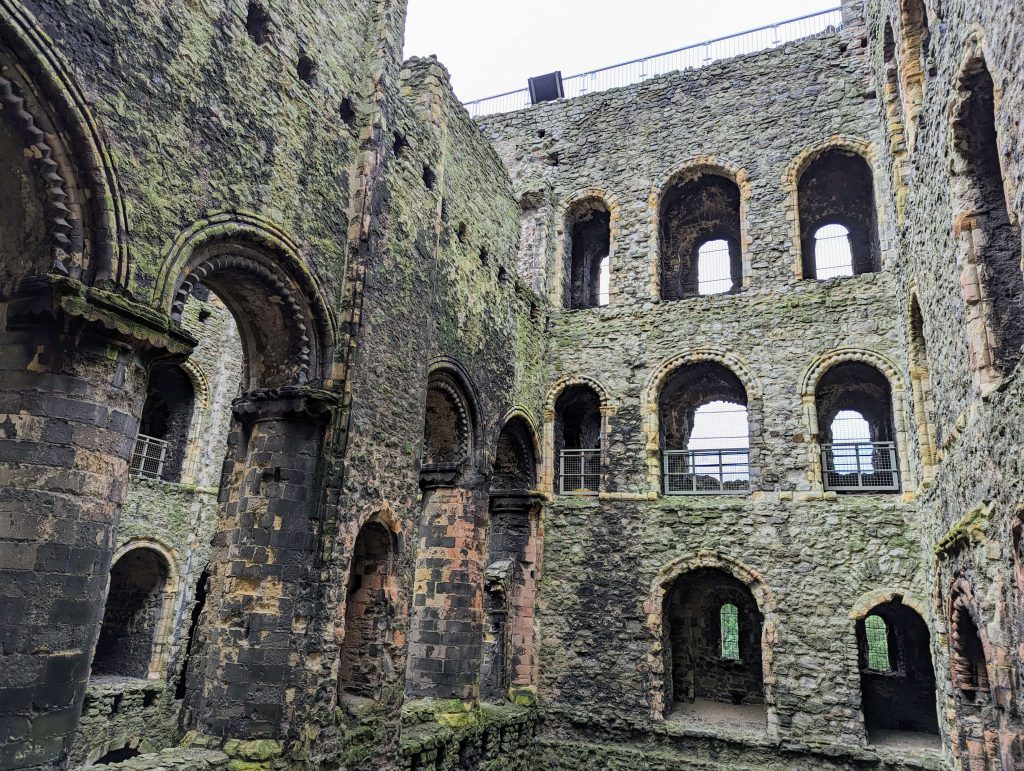
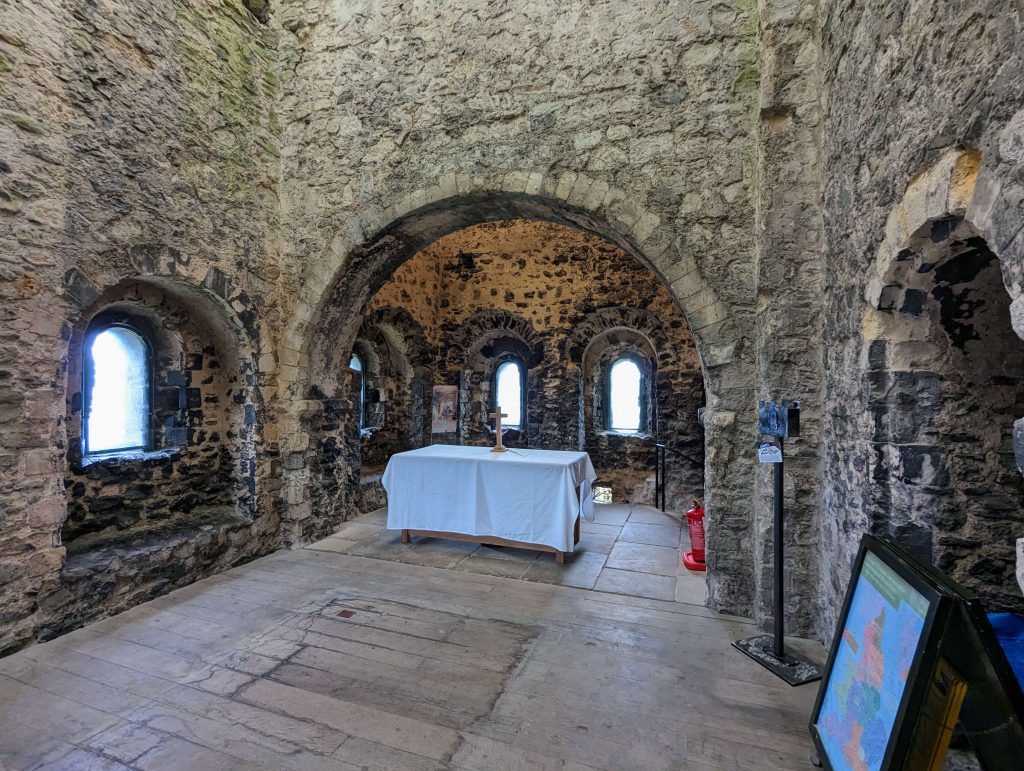
Siege engines hurled stones continuously at the castle’s walls but to little effect, so John tried another tactic, undermining. A mine was dug under the south-east corner of the keep and John sent a letter requesting “forty of the fattest pigs of the sort least good for eating to bring fire to the tower”. Wooden props supporting the tunnel underneath the tower were set alight using the pigs fat and the tunnel collapsed bringing down the tower above with it.
The castle’s garrison retreated behind the stone partition in the keep and held on but conditions dramatically worsened and to stave off starvation they ate horse flesh. Less able members of the garrison were sent out and it is said that those who did had their hands and feet chopped off by the king’s forces.
Eventually on 30th November the garrison surrendered rather than starve. John intended to execute all the garrison but was persuaded to restrain from doing so to deter rebels granting the same treatment to royal garrisons if the situation arose. John instead executed only one man, a crossbowman who John had apparently fostered since childhood.
John’s war with the barons continued but he died the following year in 1216 of dysentery. John was succeeded by his son Henry III, who was only nine years old at the time.
Henry III – Repair and Then War Again
On November 12, 1216, the Magna Carta was reissued in the name of King Henry III, albeit with the omission of certain clauses. This reissued version was sealed by the highly respected regent William Marshal, who was entrusted with governing on behalf of the young king. Over time, Marshal successfully secured the support of a majority of the barons for King Henry III’s reign.
Henry III is said to have visited Rocheseter at least once a year and spent vast sums of money repairing and enhancing Rochester Castle. The south-east tower that fell in the siege was rebuilt but unlike the other square turrets it was rebuilt in a circular plan to help prevent undermining. A chapel, new gatehouse, stables and other residential buildings were constructed and repair work on the curtain wall, hall, buttery and dispensary were carried out.
Henry III’s reign did not remain peaceful, as the barons became dissatisfied with his leadership, as they had with his fathers, ultimately sparking the Second Barons’ War in 1264, under the leadership of Simon de Montfort, the Earl of Leicester.

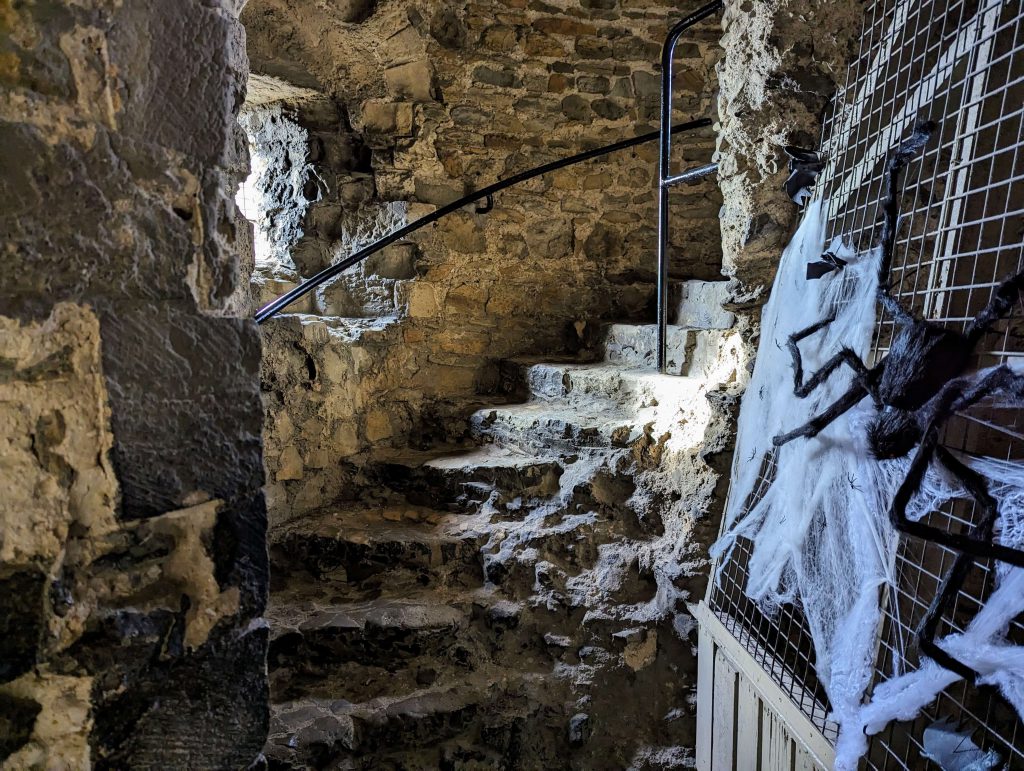
On 17th April 1264, a baronial army led by Gilbert de Clare, Earl of Hertford, attacked Rochester. Simon de Montfort marched with an army from London to join the siege but struggled to find a way to cross the river Medway, on his third attempt with the help of a fire ship he was successful. Smoke from the ship may have been used to disguise his movements or to destroy the bridge whilst he moved across the water.
De Montfort and de Clare now worked together in a coordinated attack with their armies. That night they breached the city and raided the cathedral and the following day they set their sights on the castle. They breached the castle bailey and discovered the King’s Hall had been burnt down by the garrison to thwart the attackers’ use of it and the defenders retreated into the keep. The following day was Easter Sunday and a brief truce was called but on Monday the siege resumed.
For a week, siege engines bombarded the castle causing damage but the castle stood strong as it had done in the 1215 siege, as before the besiegers moved to undermining tactics but with news of a royal relief army on its way, the rebels took fright and abandoned the siege before their tunnels were completed.
Burnt Out and Forgotten
Again Rochester Castle had proved itself impenetrable but the castle had been greatly damaged during the siege and was badly in need of repair but it had a long wait before it received any aid. In 1275, the castle’s constables not only neglected to make any attempts to restore the structure but also exacerbated its deterioration by pilfering stone from the castle for use in other projects and in 1281, permission was to demolish the castle’s hall and chambers.
As the castle was no longer being used as a royal residence it was put to use as a prison. Elizabeth de Burgh, the Queen of Scots and wife of Robert the Bruce, who was captured by the English in 1306, was imprisoned in the castle from March to June of 1314.
The castle continued to decline and was badly damaged in the great storms that truck England in March 1363.
During the reign of Richard II Rochester Castle experienced its last conflict during the Peasants’ Revolt of 1381. It came under siege and was eventually captured by a faction of rebels who ransacked the castle and released a prisoner. Earlier that same year another disaster had struck when Rochester bridge collapsed.
Richard II spent a considerable amount on building a new tower overlooking the bridge over the Medway.. This was likely due to the threat of French invasion along the south coast during the Hundred Years’ War.
From the 15th century through to the late 16th century little is known about what happened and who resided at Rochester Castle. In the latter part of the 16th century, Rochester Castle had become entirely obsolete, and during the reign of Elizabeth I (1558–1603), she authorised the extraction of stone from the castle’s curtain wall to construct the new fort at Upnor.
During the English Civil War, the city of Rochester was captured by Royalists in 1648, however Rochester Castle played no part in the war, indicating that by this point it was in such a ruinous state that it could not be fortified. It also managed to escape the fate of so many English castles of being slighted (destroyed), this could have been because it was not considered a military risk or that Anthony Weldon, who was in control of the castle at the time was a Parliamentarian.
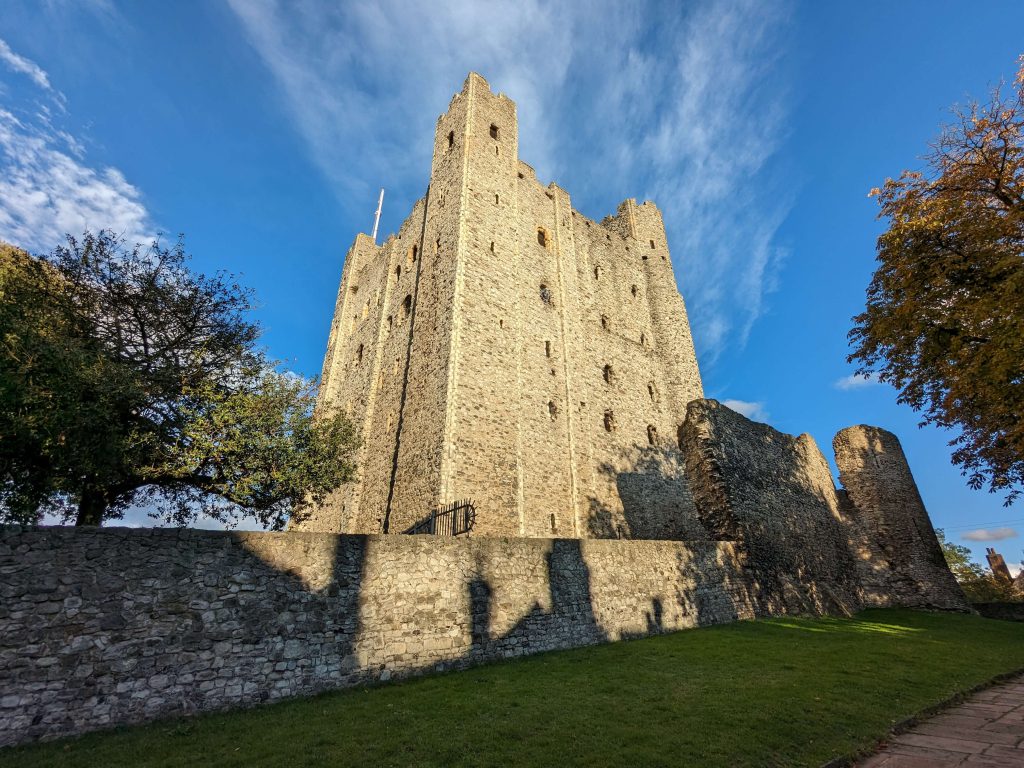
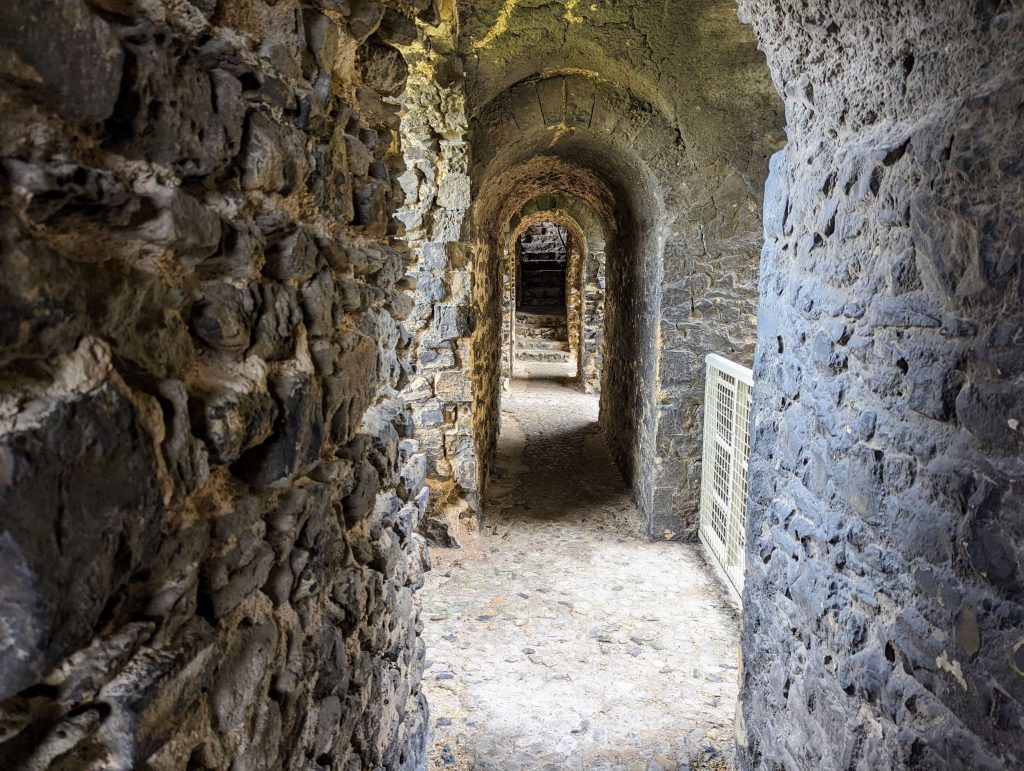
At an unspecified moment in history, a significant fire erupted at the castle, casting a reddish hue to the stonework. The origins of this blaze remain shrouded in mystery.
In the late 18th century one of J M W Turner’s most famous paintings was inspired by the ruins of Rochester Castle.
By the 19th century, gardens were established within the castle’s enclosure. Notably, Charles Dickens, who resided in Rochester, featured the castle ruins in his works, including “The Pickwick Papers” and “The Mystery of Edwin Drood.” It is said that Rochester Castle left such an impression on Dickins that his ghost haunts the moat on Christmas Eve.
Rochester Castle Today
In 1872, the castle grounds were opened as a park with the castle as a picturesque ruin covered in ivy (the ivy was removed between 1919 and 1931). In 1965, the responsibility for Rochester Castle was transferred to the Ministry of Works. Unfortunately, records documenting the conservation efforts conducted by the Ministry have been lost or gone missing over time, making it unclear precisely what restoration work was undertaken.
In 1984, the guardianship of Rochester Castle passed to English Heritage. Then, since 1995, the City of Rochester has taken on the responsibility for the day-to-day management and upkeep of the castle. The castle is open to the public to enjoy and it continues to captivate visitors as one of the most impressive Norman fortresses, offering a window into the rich tapestry of time. For more information on visiting Rochester Castle visit the English Heritage website.
Click below to explore Rochester Castle with us

